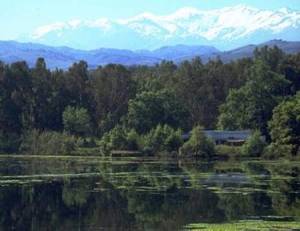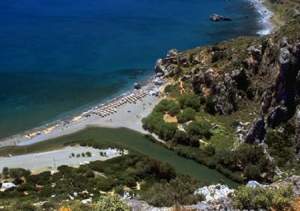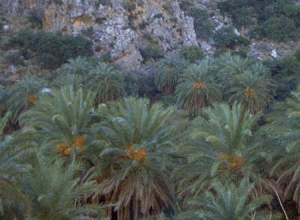Island of Crete
 Crete
is the largest of the Greek islands, the fifth largest island
in the Mediterranean, and is equidistant to Europe, Africa
and Asia. Some 256 kms long, and between 15 and 60 kms wide,
majestic mountains rise in its centre with their plateaus
split by deep ravines ending up in fertile valleys and sandy
beaches. Crete
is the largest of the Greek islands, the fifth largest island
in the Mediterranean, and is equidistant to Europe, Africa
and Asia. Some 256 kms long, and between 15 and 60 kms wide,
majestic mountains rise in its centre with their plateaus
split by deep ravines ending up in fertile valleys and sandy
beaches.
A high mountain range crosses
the island from West to East, formed by three different groups
of mountains. To the west side the White Mountains (2.452
m), in the middle the mountain of Idi (Psiloritis-2.456 m)
and to the East the mountain of Dikti (2.148 m). These mountains
gifted Crete with fertile plateaus like Lasithi and Omalos,
caves like Diktaion and "Idaion Andron", and gorges
like the famous Gorge of Samaria and Imbros.
Crete is the most significant
of the Greek islands since European culture first developed
here over 4000 years with the Minoan civilization. The Island
has a long history that goes back to the Neolithic times.
It is however known for the Minoan civilization the flourished
from 2600 to 1100 B.C. The island is full of relics of the
Minoan ages the most famous being the palaces at Knossos and
Faistos.
 Crete
is divided to four prefectures: Chania,
Rethymno, Heraklion
and Agios Nikolaos (Lasithi). Crete
is divided to four prefectures: Chania,
Rethymno, Heraklion
and Agios Nikolaos (Lasithi).
The capital of the island is the city of Heraklion.
The Cretan climate provides for
the cultivation of olives,
grapes, carobs, miniature bananas, melons, peaches, avocados,
oranges, tomatoes and numerous kinds of mountain greens (horta)
to name a few.
The nature
is very rich of different species since there are 2000+ different
plant species with approximately 10 % being endogenous in
the island.
The population involves in many activities,
providing the economy of the island
which is growing very fast, last years.
The economy should never
increased without the high quality education
institutes that are hosted in the island.
 Chania
is Crete's second largest city and was the capital until 1972.
It's history is particularly interesting as in the past invaders
always focussed in this area. You’ll find traces of Byzantine,
Venetian, Turkish and Germans times here. Linear B tablets
discovered indicate that Chania
was the site of the Minoan city of Kydonia. Chania
is Crete's second largest city and was the capital until 1972.
It's history is particularly interesting as in the past invaders
always focussed in this area. You’ll find traces of Byzantine,
Venetian, Turkish and Germans times here. Linear B tablets
discovered indicate that Chania
was the site of the Minoan city of Kydonia.
Tourism
has brought more prosperity to the island and whilst the east
of Crete has more concentrated tourism the west is drawing
more and more visitors and nowadays Chania
has quite a cosmopolitan air. The north coast is more developed
with its airport, sea port and
easy road access but the south west also has its fair share
of visitors these days. A number of internationally
famous people were born to Chania.
Activities
| Climate | Cultivation
| Economy | Education
| Nature |
Tourism | Transportation
|
